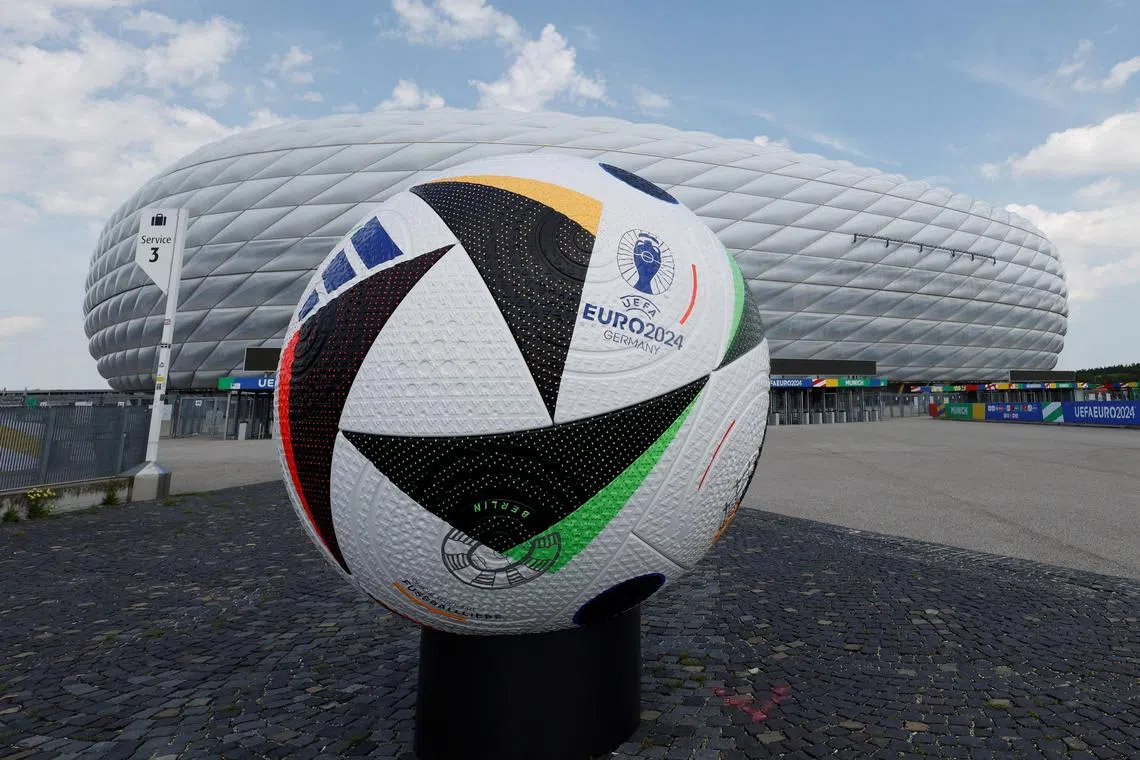Crypto football tokens shine ahead of summer of sport
Sign up now: Get ST's newsletters delivered to your inbox

Activity in tokens linked to participating national teams has increased ahead of the 2024 European Football Championship.
PHOTO: REUTERS
Follow topic:
Bengaluru – As football fever builds for major tournaments in Europe and the Americas, a small yet buzzy part of the cryptoverse is stealing centre stage: fan tokens.
These are not your average digital assets – they are tokens issued by national sides or individual clubs that promise supporters a tradeable way to engage with their teams.
Activity in tokens linked to participating national teams has increased ahead of the 2024 European Football Championship, which kicks off on June 14, and the Copa America in North and South America that starts a week later.
The market value of the Chiliz cryptocurrency – the native coin of the Socios blockchain which hosts most major fan tokens, and thus a broad proxy for the niche sector – has climbed to more than US$1.07 billion (S$1.45 billion) from about US$687 million at the start of the year and is nearing levels last seen around the 2022 World Cup, according to data from CoinGecko.
Trading volumes of fan tokens have also picked up in recent months, registering more than US$170 million on May 24, versus between US$25 million and US$57 million for most of January, according to data from Kaiko. The total market value of listed fan tokens stands at around US$413 million, CoinGecko data shows.
This summer of sport could be a key test for the still-nascent sector of fan tokens, which typically offer perks like raffle entries, early ticket access, merchandise discounts, or chances to vote on minor decisions such as match songs.
Backers laud the tokens as a rare example of real-world crypto utility, while critics highlight the tensions between the stated purpose of team engagement and the speculative – and risky – nature of tradeable assets.
A spokesperson for Chiliz said the company’s marketing was clear that “fan tokens are fan-engagement tools and should be used as such”.
The price of Portugal’s fan token has risen about 2 per cent in the past 30 days to US$2.94, while Argentina’s token briefly touched its highest level since 2022 at US$2.46 – though both are still trading below their peaks hit around the 2022 World Cup.
“There has been a major uptick in trading volumes but we expect it to be short-lived,” said Mr Jag Kooner, head of derivatives at Bitfinex, pointing to a drop-off in trading following the World Cup.
Many top football teams and sports stars promoted crypto assets – such as non-fungible tokens (NFTs) or fan tokens – to supporters during a previous crypto boom in 2021, drawing the ire of critics who warned they might encourage financial speculation.
British lawmakers warned in 2023 that the rise of NFTs in sport was putting supporters at risk of financial harm and potentially damaging the reputations of clubs.
Meanwhile, the football supporters’ association of England and Wales has dismissed fan token partnerships as “trying to monetise trivial matters” or “inserting financial barriers into genuine supporter engagement”.
Changes in token volume and price do not always correspond with team performance, noted Mr Adam McCarthy, research analyst at Kaiko.
“I don’t see evidence that holders benefit from holding these tokens as a sort of bet on the respective teams’ success,” he said.
A study analysing fan token trading around major sporting events found that it often aligns with a “buy the rumour, sell the news” pattern that is found in traditional finance. Volumes and returns typically rise ahead of major tournaments, then fall at the onset of important matches.
On the other hand, another study found fans who buy tokens typically take advantage of the benefits offered via voting on club-related decisions.
“When fans are given a chance to influence club decisions, they engage substantively,” said Mr Lennart Ante, who worked on both studies and is chief executive of the Blockchain Research Lab.
“The dual nature of fan tokens as both engagement tools and speculative assets creates a dichotomy,” he added. “The future of fan tokens could hinge on how this distribution between engagement-focused users and speculators evolves.” REUTERS

